InAs/InAsSb Strained-Layer Superlattice Mid-Wavelength Infrared Detector for High-Temperature Operation
Abstract
:1. Introduction
2. Strained-Layer Superlattice (SLS) Design and Detector Structure
3. Characteristics of Detectors
4. Discussion
5. Conclusions
Author Contributions
Funding
Acknowledgments
Conflicts of Interest
References
- Martyniuk, P.; Rogalski, A. HOT infrared photodetectors. Opto Electron. Rev. 2013, 21, 239–257. [Google Scholar] [CrossRef]
- Rogalski, A.; Martyniuk, P.; Kopytko, M. Antimonide-Based Infrared Detectors–A New Perspective; SPIE Press: Bellingham, WA, USA, 2018. [Google Scholar]
- Pour, S.A.; Huang, E.K.; Chen, G.; Haddadi, A.; Nguyen, B.M.; Razeghi, M. High operating temperature midwave infrared photodiodes and focal plane arrays based on type-II InAs/GaSb superlattices. Appl. Phys. Lett. 2011, 98, 143501. [Google Scholar] [CrossRef]
- Ting, D.Z.; Soibel, A.; Khoshakhlagh, A.; Rafol, S.B.; Keo, S.A.; Höglund, L.; Fisher, A.M.; Luong, E.M.; Gunapala, S.D. Mid-wavelength high operating temperature barrier infrared detector and focal plane array. Appl. Phys. Lett. 2018, 113, 021101. [Google Scholar] [CrossRef]
- Maimon, S.; Wicks, G.W. nBn detector, an infrared detector with reduced dark current and higher operating temperature. Appl. Phys. Lett. 2006, 89, 151109. [Google Scholar] [CrossRef]
- Klem, J.F.; Kim, J.K.; Cich, M.J.; Hawkins, S.D.; Fortune, T.R.; Rienstra, J.L. Comparison of nBn and nBp Mid-Wave Barrier Infrared Photodetectors; SPIE Press: Bellingham, WA, USA, 2010; Volume 7608. [Google Scholar]
- Plis, E.A.; Krishna, S.S.; Gautam, N.; Myers, S.; Krishna, S. Bias Switchable Dual-Band InAs/GaSb Superlattice Detector With pBp Architecture. Photonics J. IEEE 2011, 3, 234–240. [Google Scholar] [CrossRef]
- Klipstein, P. “XBn” barrier photodetectors for high sensitivity and high operating temperature infrared sensors. SPIE Proc. 2008, 6940, 69402U. [Google Scholar]
- Ting, D.Z.Y.; Hill, C.J.; Soibel, A.; Keo, S.A.; Mumolo, J.M.; Nguyen, J.; Gunapala, S.D. A high-performance long wavelength superlattice complementary barrier infrared detector. Appl. Phys. Lett. 2009, 95, 023508. [Google Scholar] [CrossRef]
- Nolde, J.A.; Jackson, E.M.; Bennett, M.F.; Affouda, C.A.; Cleveland, E.R.; Canedy, C.L.; Vurgaftman, I.; Jernigan, G.G.; Meyer, J.R.; Aifer, E.H. Reticulated shallow etch mesa isolation for controlling surface leakage in GaSb-based infrared detectors. Appl. Phys. Lett. 2017, 111, 051102. [Google Scholar] [CrossRef]
- Chang, L.L.; Esaki, L. Electronic properties of InAs-GaSb superlattices. Surf. Sci. 1980, 98, 70–89. [Google Scholar] [CrossRef]
- Mailhiot, C.; Smith, D.L. Long-wavelength infrared detectors based on strained InAs/Ga1−xInxSb type-II superlattices. J. Vac. Sci. Technol. A Vac. Surf. Films 1989, 7, 445–449. [Google Scholar] [CrossRef]
- Nguyen, B.M.; Hoffman, D.; Delaunay, P.Y.; Razeghi, M. Dark current suppression in type II InAs/GaSb superlattice long wavelength infrared photodiodes with M-structure barrier. Appl. Phys. Lett. 2007, 91, 163511–163513. [Google Scholar] [CrossRef]
- Aifer, E.H.; Tischler, J.G.; Warner, J.H.; Vurgaftman, I.; Bewley, W.W.; Meyer, J.R.; Kim, J.C.; Whitman, L.J.; Canedy, C.L.; Jackson, E.M. W-structured type-II superlattice long-wave infrared photodiodes with high quantum efficiency. Appl. Phys. Lett. 2006, 89, 053519. [Google Scholar] [CrossRef]
- Ariyawansa, G.; Reyner, C.J.; Steenbergen, E.H.; Duran, J.M.; Reding, J.D.; Scheihing, J.E.; Bourassa, H.R.; Liang, B.L.; Huffaker, D.L. InGaAs/InAsSb strained layer superlattices for mid-wave infrared detectors. Appl. Phys. Lett. 2016, 108, 022106. [Google Scholar] [CrossRef]
- Steenbergen, E.H.; Connelly, B.C.; Metcalfe, G.D.; Shen, H.; Wraback, M.; Lubyshev, D.; Qiu, Y.; Fastenau, J.M.; Liu, A.W.K.; Elhamri, S.; et al. Significantly improved minority carrier lifetime observed in a long-wavelength infrared III-V type-II superlattice comprised of InAs/InAsSb. Appl. Phys. Lett. 2011, 99, 251110. [Google Scholar] [CrossRef]
- Höglund, L.; Ting, D.Z.; Soibel, A.; Fisher, A.; Khoshakhlagh, A.; Hill, C.J.; Keo, S.; Gunapala, S.D. Minority carrier lifetime in mid-wavelength infrared InAs/InAsSb superlattices: Photon recycling and the role of radiative and Shockley-Read-Hall recombination mechanisms. Appl. Phys. Lett. 2014, 105, 193510. [Google Scholar] [CrossRef]
- Kadlec, E.A.; Olson, B.V.; Goldflam, M.D.; Kim, J.K.; Klem, J.F.; Hawkins, S.D.; Coon, W.T.; Cavaliere, M.A.; Tauke-Pedretti, A.; Fortune, T.R.; et al. Effects of electron doping level on minority carrier lifetimes in n-type mid-wave infrared InAs/InAs1-xSbx type-II superlattices. Appl. Phys. Lett. 2016, 109, 261105. [Google Scholar] [CrossRef]
- Rogalski, A.; Kopytko, M.; Martyniuk, P. InAs/GaSb type-II superlattice infrared detectors: Three decades of development. In Infrared Technology and Applications XLIII; SPIE Press: Bellingham, WA, USA, 2017; p. 1017715. [Google Scholar]
- Ariyawansa, G.; Reyner, C.J.; Duran, J.M.; Reding, J.D.; Scheihing, J.E.; Steenbergen, E.H. Unipolar infrared detectors based on InGaAs/InAsSb ternary superlattices. Appl. Phys. Lett. 2016, 109, 021112. [Google Scholar] [CrossRef]
- Olson, B.V.; Klem, J.F.; Kadlec, E.A.; Kim, J.K.; Goldflam, M.D.; Hawkins, S.D.; Tauke-Pedretti, A.; Coon, W.T.; Fortune, T.R.; Shaner, E.A.; et al. Vertical Hole Transport and Carrier Localization in InAs/InAsSb Type-II Superlattice Heterojunction Bipolar Transistors. Phys. Rev. Appl. 2017, 7, 024016. [Google Scholar] [CrossRef]
- Rhiger, D.R.; Smith, E.P. Carrier Transport in the Valence Band of nBn III–V Superlattice Infrared Detectors. J. Electron. Mater. 2019, 48, 6053–6062. [Google Scholar] [CrossRef]
- Steenbergen, E.H.; Massengale, J.A.; Ariyawansa, G.; Zhang, Y.H. Evidence of carrier localization in photoluminescence spectroscopy studies of mid-wavelength infrared InAs/InAs1−xSbx type-II superlattices. J. Lumin. 2016, 178, 451–456. [Google Scholar] [CrossRef]
- Huang, E.K.; Hoffman, D.; Nguyen, B.; Delaunay, P.; Razeghi, M. Surface leakage reduction in narrow band gap jour-II antimonide-based superlattice photodiodes. Appl. Phys. Lett. 2009, 94, 053506. [Google Scholar] [CrossRef]
- Sidor, D.E.; Savich, G.R.; Wicks, G.W. Surface Leakage Mechanisms in III–V Infrared Barrier Detectors. J. Electron. Mater. 2016, 45, 4663–4667. [Google Scholar] [CrossRef]
- Lumb, M.P.; Vurgaftman, I.; Affouda, C.A.; Meyer, J.R.; Aifer, E.H.; Walters, R.J. Quantum wells and superlattices for III-V photovoltaics and photodetectors. SPIE Proc. 2012, 8471, 84710A. [Google Scholar]
- Ariyawansa, G.; Steenbergen, E.; Bissell, L.J.; Duran, J.M.; Scheihing, J.E.; Eismann, M.T. Absorption characteristics of mid-wave infrared type-II superlattices. SPIE Proc. 2014, 9070, 90701J. [Google Scholar]
- Urbach, F. The Long-Wavelength Edge of Photographic Sensitivity and of the Electronic Absorption of Solids. Phys. Rev. 1953, 92, 1324. [Google Scholar] [CrossRef]
- Tennant, W.E.; Lee, D.; Zandian, M.; Piquette, E.; Carmody, M. MBE HgCdTe Technology: A Very General Solution to IR Detection, Described by ‘‘Rule 07’’, a Very Convenient Heuristic. J. Electron. Mater. 2008, 37, 1406. [Google Scholar] [CrossRef]
- Rhiger, D.R.; Smith, E.P.; Kolasa, B.P.; Kim, J.K.; Klem, J.F.; Hawkins, S.D. Analysis of III–V Superlattice nBn Device Characteristics. J. Electron. Mater. 2016, 45, 4646–4653. [Google Scholar] [CrossRef]
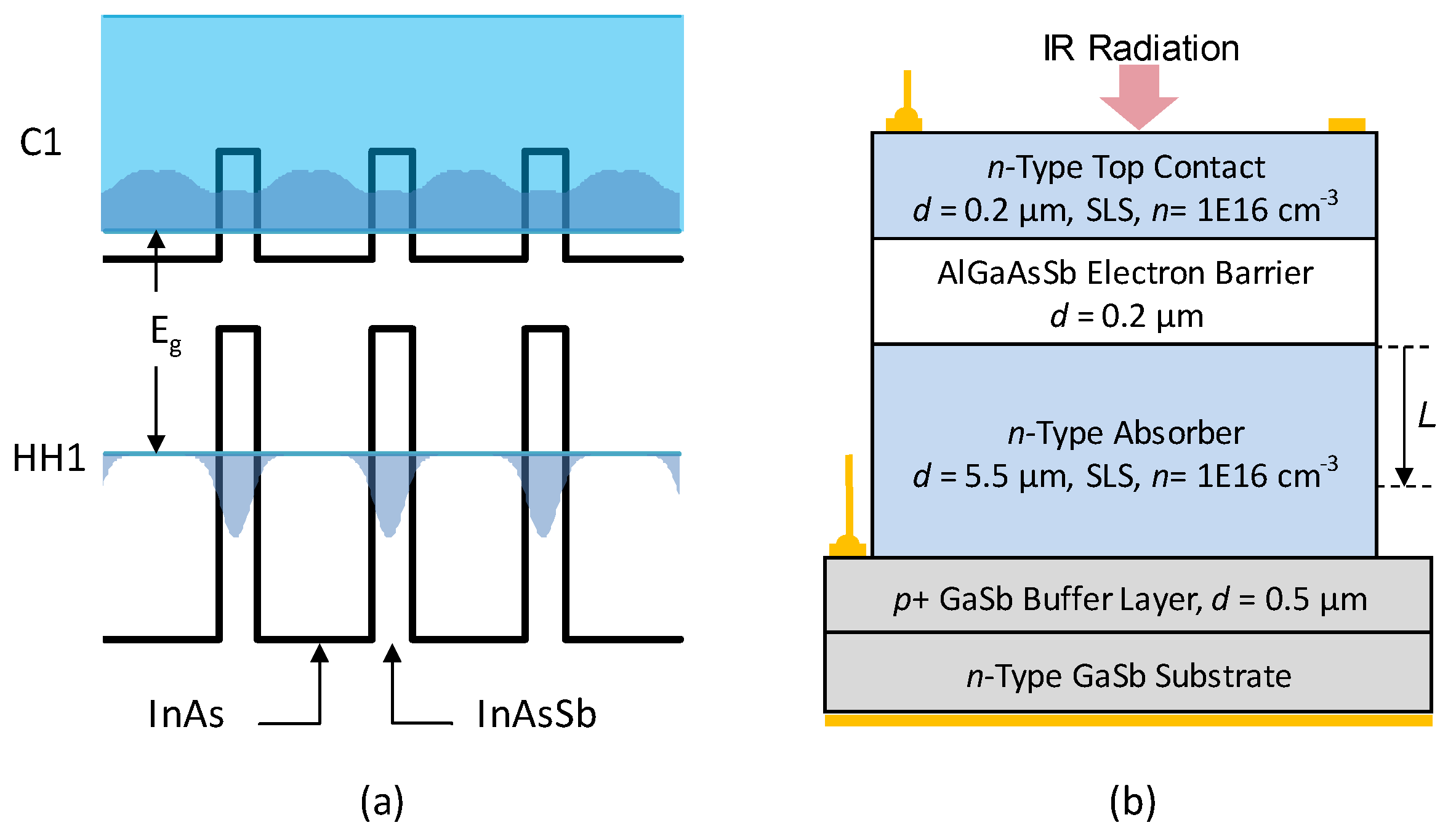
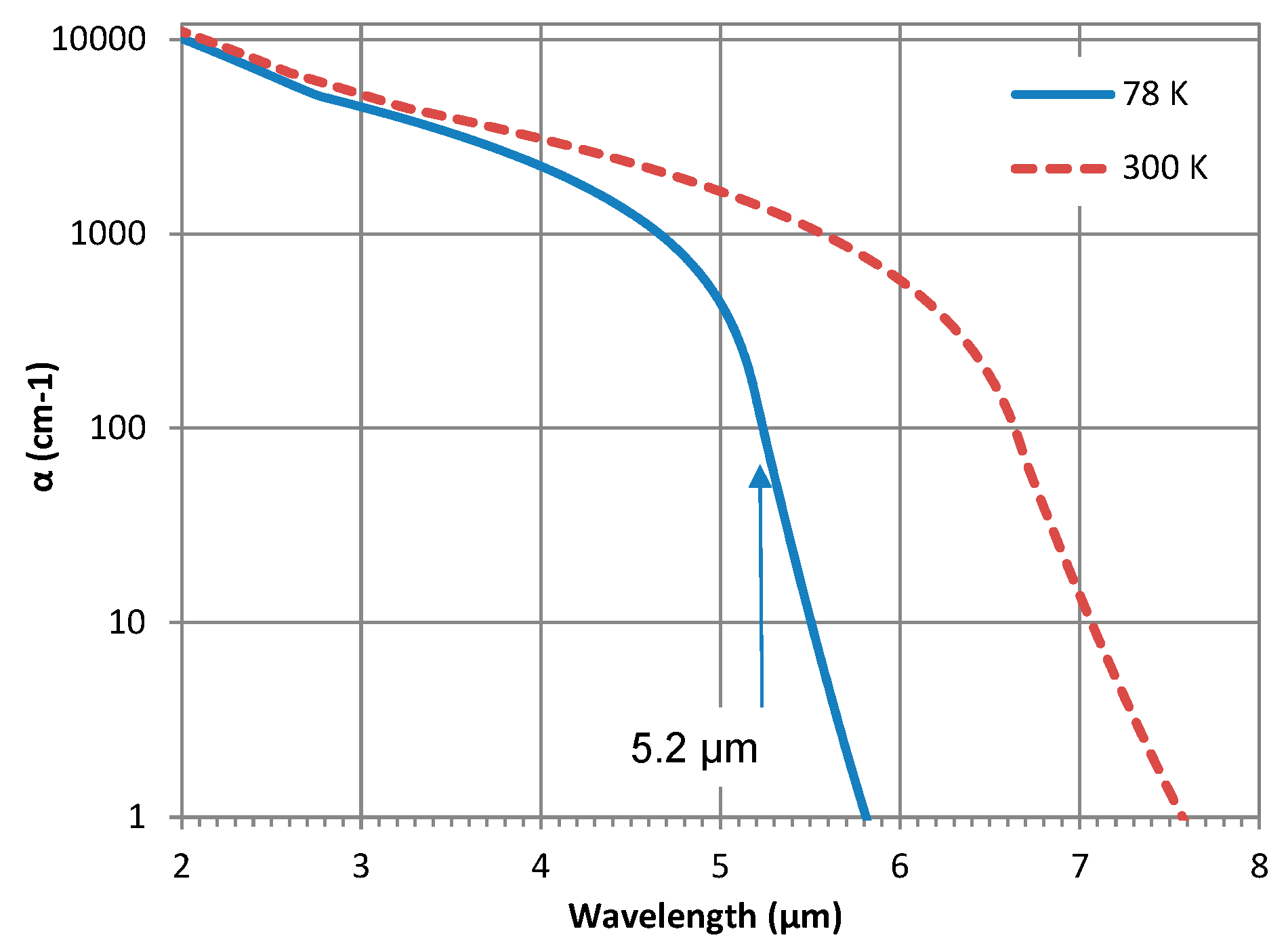

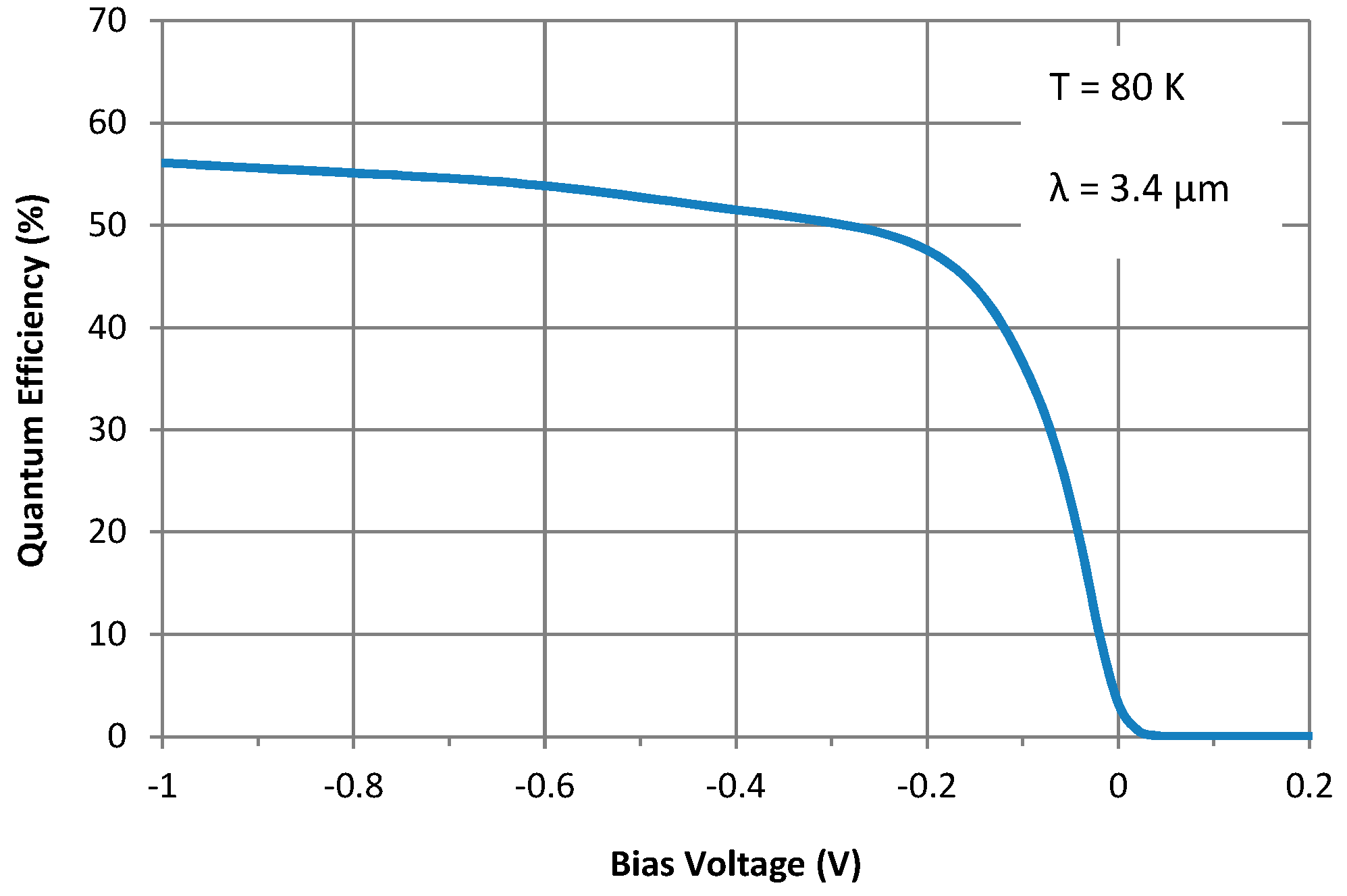
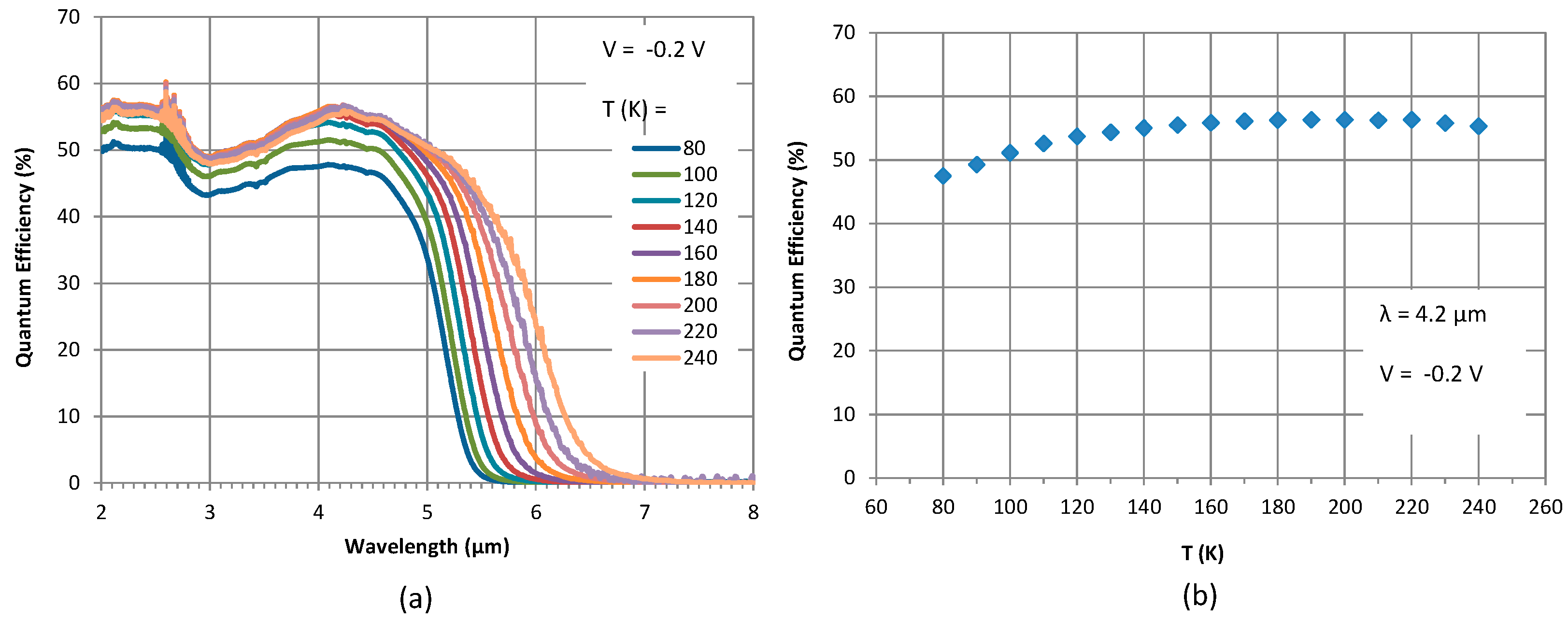
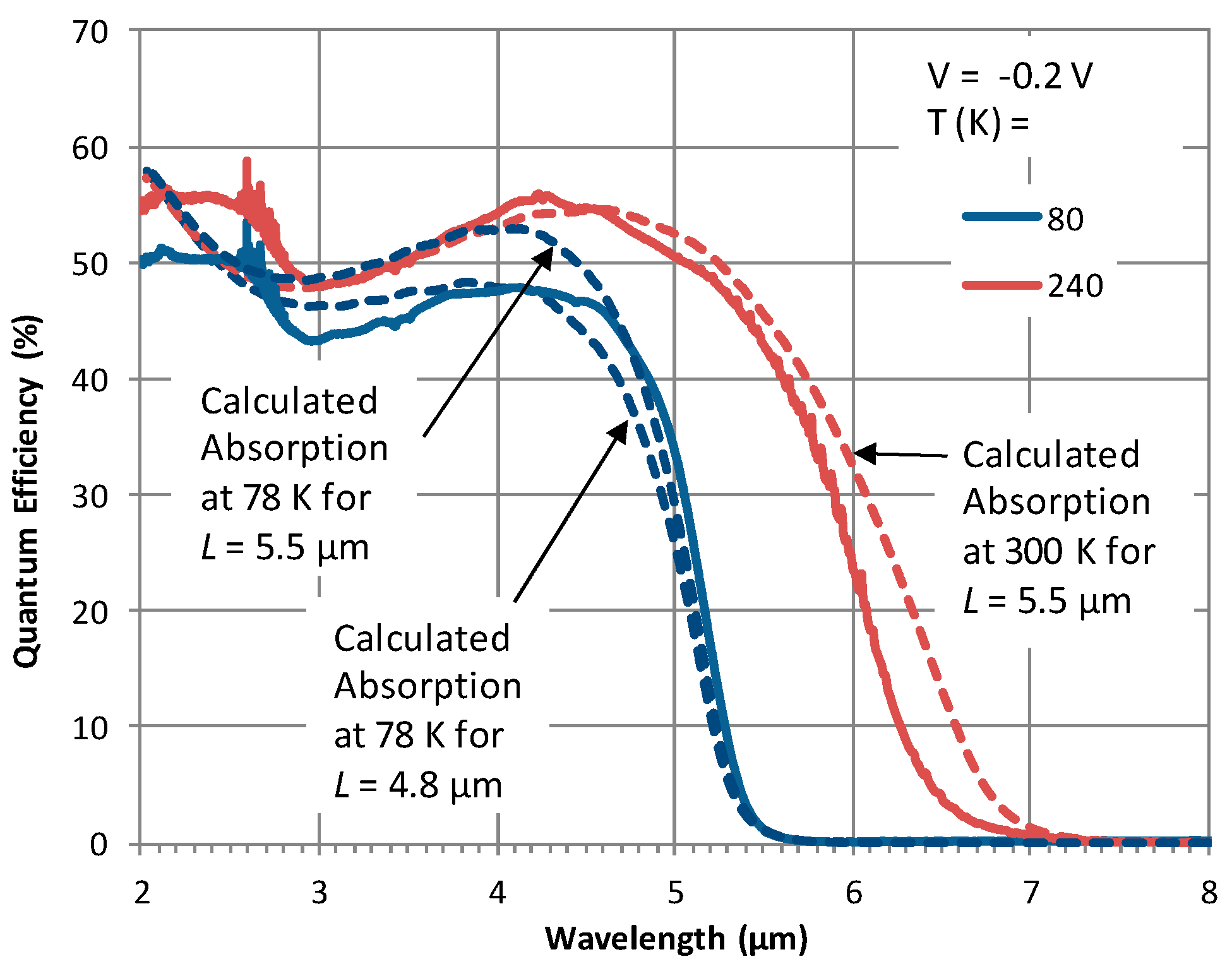

© 2019 by the authors. Licensee MDPI, Basel, Switzerland. This article is an open access article distributed under the terms and conditions of the Creative Commons Attribution (CC BY) license (http://creativecommons.org/licenses/by/4.0/).
Share and Cite
Ariyawansa, G.; Duran, J.; Reyner, C.; Scheihing, J. InAs/InAsSb Strained-Layer Superlattice Mid-Wavelength Infrared Detector for High-Temperature Operation. Micromachines 2019, 10, 806. https://doi.org/10.3390/mi10120806
Ariyawansa G, Duran J, Reyner C, Scheihing J. InAs/InAsSb Strained-Layer Superlattice Mid-Wavelength Infrared Detector for High-Temperature Operation. Micromachines. 2019; 10(12):806. https://doi.org/10.3390/mi10120806
Chicago/Turabian StyleAriyawansa, Gamini, Joshua Duran, Charles Reyner, and John Scheihing. 2019. "InAs/InAsSb Strained-Layer Superlattice Mid-Wavelength Infrared Detector for High-Temperature Operation" Micromachines 10, no. 12: 806. https://doi.org/10.3390/mi10120806
APA StyleAriyawansa, G., Duran, J., Reyner, C., & Scheihing, J. (2019). InAs/InAsSb Strained-Layer Superlattice Mid-Wavelength Infrared Detector for High-Temperature Operation. Micromachines, 10(12), 806. https://doi.org/10.3390/mi10120806




